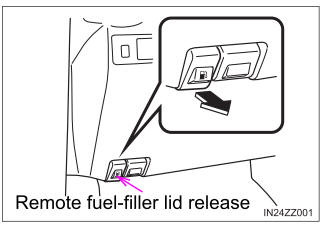Toyota Yaris: Meter / Gauge System / How To Proceed With Troubleshooting
CAUTION / NOTICE / HINT
HINT:
- Use the following procedure to troubleshoot the meter / gauge system.
- *: Use the GTS.
PROCEDURE
| 1. | VEHICLE BROUGHT TO WORKSHOP |
|
| 2. | CUSTOMER PROBLEM ANALYSIS |
HINT:
- In troubleshooting, confirm that the problem symptoms have been accurately identified. Preconceptions should be discarded in order to make an accurate judgment. To clearly understand what the problem symptoms are, it is extremely important to ask the customer about the problem and the conditions at the time the malfunction occurred.
- Gather as much information as possible for reference. Past problems that seem unrelated may also help in some cases.
-
The following 5 items are important points for problem analysis:
What
Vehicle model, system name
When
Date, time, occurrence frequency
Where
Road conditions
Under what conditions?
Driving conditions, weather conditions
How did it happen?
Problem symptoms
|
| 3. | PRE-CHECK |
(a) Measure the auxiliary battery voltage with ignition switch off.
Standard Voltage:
11 to 14 V
If the voltage is below 11 V, recharge or replace the auxiliary battery before proceeding to the next step.
(b) Check the fuses and relays.
(c) Check the connector connections and terminals to make sure that there are no abnormalities such as loose connections, deformation, etc.
|
| 4. | CHECK CAN COMMUNICATION SYSTEM* |
(a) Using the GTS, check for CAN communication system DTCs.
Click here

| Result | Proceed to |
|---|---|
| CAN DTCs are not output | A |
| CAN DTCs are output | B |
| B |
 | GO TO CAN COMMUNICATION SYSTEM |
|
| 5. | CHECK FOR DTC* (METER / GAUGE SYSTEM) |
(a) Check for DTCs.
Body Electrical > Combination Meter > Trouble Codes| Result | Proceed to |
|---|---|
| DTCs are not output | A |
| DTCs are output | B |
| B |
 | GO TO DIAGNOSTIC TROUBLE CODE CHART |
|
| 6. | PROBLEM SYMPTOM CONFIRMATION |
|
| 7. | SYMPTOM SIMULATION |
|
| 8. | PROBLEM SYMPTOMS TABLE |
(a) Refer to Problem Symptoms Table.
Click here

| Result | Proceed to |
|---|---|
| Fault is not listed in Problem Symptoms Table | A |
| Fault is listed in Problem Symptoms Table | B |
| B |
 | GO TO PROBLEM SYMPTOMS TABLE |
|
| 9. | OVERALL ANALYSIS AND TROUBLESHOOTING* |
(a) Terminals of ECU.
Click here

(b) Data List / Active Test.
Click here

(c) On-vehicle Inspection.
Click here

(d) Inspection.
|
| 10. | CIRCUIT INSPECTION |
|
| 11. | ADJUST, REPAIR OR REPLACE |
|
| 12. | CONFIRMATION TEST |
| NEXT |
 | END |
 System Diagram
System Diagram
S..
 Customize Parameters
Customize Parameters
CUSTOMIZE PARAMETERS NOTICE:
When the customer requests a change in a function, first make sure that the function can be customized.
Be sure to make a note of the current settings before customizing...
Other information:
Toyota Yaris XP210 (2020-2025) Reapir and Service Manual: Removal
REMOVAL CAUTION / NOTICE / HINT HINT: When the cable is disconnected/reconnected to the auxiliary battery terminal, systems temporarily stop operating. However, each system has a function that completes learning the first time the system is used. Learning completes when vehicle is driven Effect/Inoperative Function When Necessary Procedures are not Performed Necessary Procedures Link Lane tracing assist system Drive the vehicle straight ahead at 35 km/h (22 mph) or more for 5 second or more...
Toyota Yaris XP210 (2020-2025) Reapir and Service Manual: Components
COMPONENTS ILLUSTRATION *1 REAR DISC BRAKE PIN HOLD CLIP *2 REAR DISC BRAKE ANTI-RATTLE PIN *3 REAR DISC BRAKE ANTI-RATTLE SPRING *4 REAR DISC BRAKE PAD *5 REAR DISC BRAKE ANTI-SQUEAL SHIM - - ILLUSTRATION *1 REAR FLEXIBLE HOSE *2 UNION BOLT *3 GASKET *4 REAR DISC BRAKE CYLINDER ASSEMBLY *5 PARKING BRAKE SHOE ADJUSTING HOLE PLUG *6 REAR DISC Tightening torque for "Major areas involving basic vehicle performance such as moving/turning/stopping": N*m (kgf*cm, ft...
Categories
- Manuals Home
- Toyota Yaris Owners Manual
- Toyota Yaris Service Manual
- Fuel Gauge
- How to use USB mode
- Key Battery Replacement
- New on site
- Most important about car
Refueling
Before refueling, close all the doors, windows, and the liftgate/trunk lid, and switch the ignition OFF.
To open the fuel-filler lid, pull the remote fuel-filler lid release.












